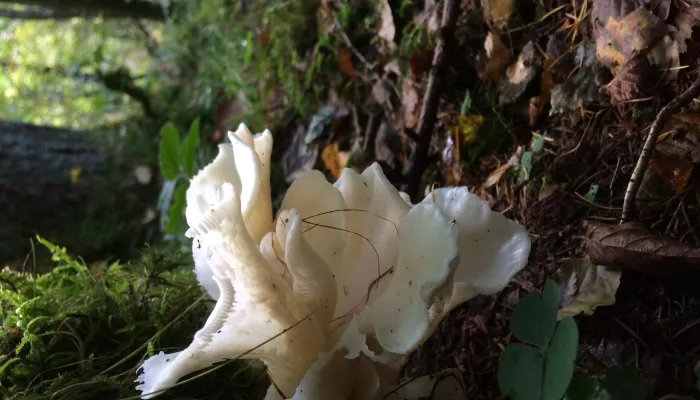| Statistics | |
| Cap diameter: | 2cm - 10cm |
The angel's wings fungus grows in overlapping clusters in the coniferous woods of Scotland and north England. Its funnel-like, white caps have no stems.
About
Angel's wings is a distinctive, white, bracket-like fungus that grows in clusters on decaying conifer wood. Relatively common in coniferous woodland in the Scottish highlands, it is also found in the south of Scotland and in Cumbria, but is it is very rare elsewhere. It is inedible. Fungi belong to their own kingdom and get their nutrients and energy from organic matter, rather than photosynthesis like plants. It is often just the fruiting bodies, or 'mushrooms', that are visible to us, arising from an unseen network of tiny filaments called 'hyphae'. These fruiting bodies produce spores for reproduction, although fungi can also reproduce asexually by fragmentation.
How to identify
Angel's wings are bracket-like fungi with white or ivory circular, funnel-shaped caps that overlap in tiers. The cap margin curves inwards and becomes undulating with age. The surface of the cap is felty. The gills are white, turning cream with age. The cap does not have a stem.
Did you know?
Once considered edible, angel's wings have been implicated in a number of fatalities in Japan, so they should be treated as deadly poisonous.
How people can help
Fungi play an important role within our ecosystems, helping to recycle nutrients from dead or decaying organic matter, and providing food and shelter for different animals. The Wildlife Trusts manage many nature reserves sympathetically for the benefit of all kinds of wildlife, including fungi: you can help by supporting your local Trust and becoming a member. Our gardens are also a vital resource for wildlife, providing corridors of green space between open countryside. Try leaving log piles and dead wood to help fungi and the wildlife that depends on it. To find out more about encouraging wildlife into your garden, visit our Wild About Gardens website: a joint initiative with the RHS.

